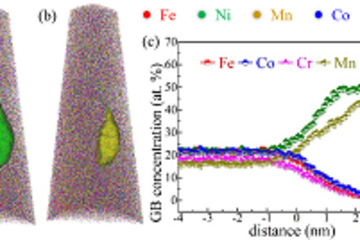All genres
181.
Journal Article
Microstructural evolution and solid state dewetting of epitaxial Al thin films on sapphire (α-Al2O3). Acta Materialia 133, pp. 356 - 366 (2017)
182.
Journal Article
Electronic structure of metastable bcc Cu–Cr alloy thin films: Comparison of electron energy-loss spectroscopy and first-principles calculations. Ultramicroscopy 178, pp. 96 - 104 (2017)
183.
Journal Article
Dislocation interaction and twinning-induced plasticity in face-centered cubic Fe–Mn–C micro-pillars. Acta Materialia 132, pp. 162 - 173 (2017)
184.
Journal Article
Dislocation-twin boundary interaction in small scale Cu bi-crystals loaded in different crystallographic directions. Acta Materialia 129, pp. 91 - 97 (2017)
185.
Journal Article
Size effect in bi-crystalline micropillars with a penetrable high angle grain boundary. Acta Materialia 129, pp. 312 - 320 (2017)
186.
Journal Article
Entwicklung intermetallischer Eisenaluminid-Legierungen. Stahl und Eisen 137 (5), p. 76 - 76 (2017)
187.
Journal Article
Beam-induced atomic migration at Ag-containing nanofacets at an asymmetric Cu grain boundary. Journal of Materials Research 32 (5), pp. 968 - 982 (2017)
188.
Journal Article
Microcantilever Fracture Testing of Intermetallic Cu3Sn in Lead-Free Solder Interconnects. Journal of Electronic Materials 46 (3), pp. 1607 - 1611 (2017)
189.
Journal Article
Mechanical size effects in a single crystalline equiatomic FeCrCoMnNi high entropy alloy. Scripta Materialia 129, pp. 52 - 55 (2017)
190.
Journal Article
Effect of annealing on the size dependent deformation behavior of thin cobalt films on flexible substrates. Thin Solid Films 624, pp. 34 - 40 (2017)
191.
Journal Article
Surface optical phonon propagation in defect modulated nanowires. Journal of Applied Physics 121 (8), 085702, pp. 1 - 6 (2017)
192.
Journal Article
In–situ TEM study of diffusion kinetics and electron irradiation effects on the Cr phase separation of a nanocrystalline Cu–4 at.% Cr thin film alloy. Journal of Alloys and Compounds 695, pp. 1583 - 1590 (2017)
193.
Journal Article
Stability, phase separation and oxidation of a supersaturated nanocrystalline Cu–33 at.% Cr thin film alloy. Thin Solid Films 623, pp. 48 - 58 (2017)
194.
Journal Article
Pre- and post-buckling behavior of bi-crystalline micropillars: Origin and consequences. Acta Materialia 124, pp. 195 - 203 (2017)
195.
Journal Article
Stress intensity factor dependence on anisotropy and geometry during micro-fracture experiments. Scripta Materialia 127, pp. 76 - 78 (2017)
196.
Journal Article
Kinetics and crystallization path of a Fe-based metallic glass alloy. Acta Materialia 127, pp. 341 - 350 (2017)
197.
Journal Article
Nanostructure of and structural defects in a Mo2BC hard coating investigated by transmission electron microscopy and atom probe tomography. Journal of Applied Physics 122 (7), 075305, pp. 1 - 9 (2017)
198.
Journal Article
Konkurrenzlose Festigkeit durch extremes Umformen von Stahl. Stahl und Eisen 137 (8), p. 58 - 58 (2017)
199.
Journal Article
Gold-Palladium Bimetallic Catalyst Stability: Consequences for Hydrogen Peroxide Selectivity. ACS Catalysis 7 (9), pp. 5699 - 5705 (2017)
200.
Journal Article
Maintaining strength in supersaturated copper–chromium thin films annealed at 0.5 of the melting temperature of Cu. Journal of Materials Science 52 (2), pp. 913 - 920 (2017)











